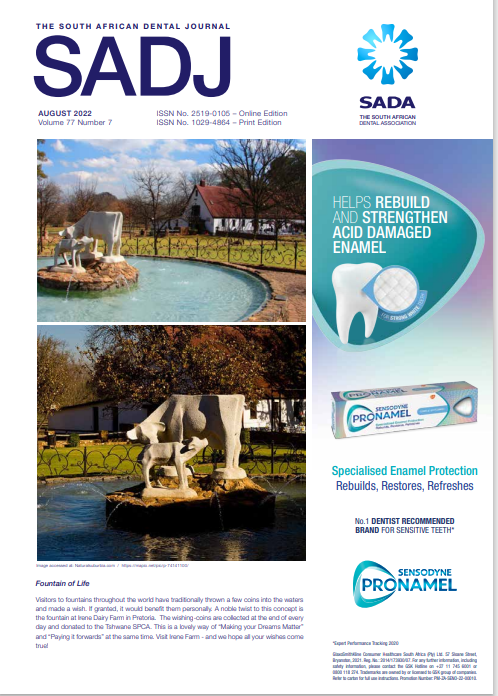Clinical academic staffing levels at a South African dental school
DOI:
https://doi.org/10.17159/2519-0105/2022/v77no7a3Keywords:
demographic, scarcityAbstract
The inadequacy and skewed distribution of oral health personnel in South Africa are well-documented. Surprisingly, the staffing levels at dental schools have not previously been described. To determine the number of full-time equivalent clinical
academic staff working at the dental school of the Sefako Makgatho Health Sciences University for the five-year period 2015 to 2019.
A retrospective cross-sectional descriptive study. Data related to the demographic characteristics and employment types of clinical academic staff working at the dental school between January 2015 and December 2019 were acquired from annual reports, payroll records and school calendars and used to calculate full-time equivalents (FTE) by academic ranks and specialties. Females and Black general dental practitioners at lecturer level constituted the majority of staff. FTE of staff at lecturer level increased sharply between 2016 and 2017 (52.7 FTE vs 65.9 FTE respectively) and have since graduall declined. FTEs of staff at senior lecturer (15.8FTE vs
12.1FTE) and professorial (7.8 FTE vs 5.3FTE) levels have continued to decline. FTEs of staff working in the majority of specialties have decreased while staffing levels in Prosthodontics and Oral & Maxillofacial Surgery have increased. Staffing levels declined between 2015 and 2019
Downloads
References
van Wyk PJ, Kroon FJ, Cleaton-Jones JPE. Geographical distribution of dental operators in South Africa over the period 1972-1992. SADJ. 1994;
:457-62
Lalloo R. A national human resources plan for oral health: is it feasible? SADJ. 2007; 62(8):360-4.
Bhayat A, Chikte U. Human Resources for Oral Health Care in South Africa: A 2018 Update. Int J Environ Res. Public Health 2019; 16(10): 1668; doi:10.3390/ijerph16101668
WHO. The global health observatory. Retrieved from https://www.who.int/data/gho/indicator-metadataregistry/imr-details/5323 [Accessed 28/02/2022].
Yadav R, Rai R. Dental education: Do we really have too many graduates? Br Dent J 2016; 220 (11): 558
Bhayat A, Chikte U. The changing demographic profile of dentists and dental specialists in South Africa: 2002-2015. Int Dent J. 2018 ;68(2):91-96.
Hall T, Mejia A. Health manpower planning: principles, methods, issues. 1978, Geneva: World Health Organization.
Green A. An Introduction to Health Planning in Developing Countries: Oxford University Press, 1992.
World Health Organization. Workload Indicators of Staffing Need (WISN) Tool. Retrieved fromhttps://www.who.int/ workforcealliance/knowledge/toolkit/17/en/[Accessed 05/10/2020]
Mostert VC. Reasons why South African dentists chose a career in Dentistry, and later opted to enter an academic environment. SADJ. 2018;73(3):141-5
Gauteng Department of Health. Institutional organogram. Unpublished confidential document; 2022
HPCSA. Accreditation of undergraduate dental education and training. Unpublished confidential document; 2016
OECD (2019). Education at a Glance 2019: OECD Indicators, OECD Publishing, Paris https://www.oecd-ilibrary.org/sites/a1ef3bfe-n/index.html?itemId=/content/component/a1ef3bfe-en [Accessed 21/02/2022]
McDonald, G. (2013), “Does size matter? The impact of student-staff ratios”, Journal of Higher Education Policy and Management. 2013;35(6): 652-67.
Bhayat A, Barrie R, Motloba P, Yengopal V. The South African Schools Educational Environment: Final Year Students’ Perceptions at Four Dental Schools. JCDR 2018; 12(2): ZC40-4.
John V, Papageorge M, Jahangiri L ‘et al’. Recruitment, development, and retention of dental faculty in a changing environment. J Dent Educ. 2011;75(1):82-9.
Patel N, Petersen HJ. Would you choose an academic career? Views of current dental clinical academic trainees. Br Dent J. 2015; 218 (5): 297-301.
John V, Papageorge M, Jahangiri L ‘et al’. Recruitment, development, and retention of dental faculty in a changing environment. J Dent Educ. 2011;75(1):82-9.
Mthethwa SR, Ramphoma KJ. The referral system for specialist dental services at Sefako Makgatho Oral Health Centre: a cross-sectional study. SADJ. 2021;76(10):618-23
Dreyer WP, van Wyk CW. Peer-reviewed oral and dental research output in South Africa, 1990-1994. SADJ. 1996 ;51(12):726-9.
Cleaton-Jones P. Peer-reviewed publication output from South African dental schools 1990-2005. SADJ. RESEARCH < 405
;63(2):114-6.
Grossman ES. Participation of dental researchers at annual IADR conferences (1967-2004): drivers and passengers. SADJ. 2008;63(1):10-14.
Union of South Africa (1950). Population Registration Act, No. 30 of 1950, in SA Government Gazette.
Statistics South Africa. Labour accounts for South Africa. A discussion document by Statistics South Africa. October 2005. http://www.statssa.gov.za/publications/D0403/D0403.pdf [Accessed 21/02/2022]
Legislation - HPCSA. Retrieved from http://www.hpcsa.co.za/Legal/Regulatory Affairs/Legislation [Accessed 28/02/2022].
Breetzke GD, Hedding DW. The changing demography of academic staff at higher education institutions (HEIs) in South Africa. Higher Education 2018;76(1):145–61.
Breetzke GD, Hedding DW. The changing racial profile of academic staff at South African Higher Education Institutions (HEIs), 2005–2013, Africa Education Review. 2016; 13(2): 147-64,
Dental Schools Council. Survey of Dental Clinical Academic Staffing Levels. A report by the Dental Schools Council 2018. August 2018. https://www.dentalschoolscouncil.ac.uk/wp-content/uploads/2018/08/clinical-academic-surveydental-2018.pdf [Accessed 21/02/2022]
Norman R., Schneider M., Bradshaw D ‘et al’. Interpersonal violence: an important risk factor for disease and injury in South Africa. Popul Health Metrics 2010; 8 (1): 32
Mogajane BM, Mabongo M. Epidemiology of maxillofacial fractures at two maxillofacial units in South Africa. SADJ. 2018;73(3):132-6
Downloads
Published
Issue
Section
License

This work is licensed under a Creative Commons Attribution-NonCommercial 4.0 International License.






.png)